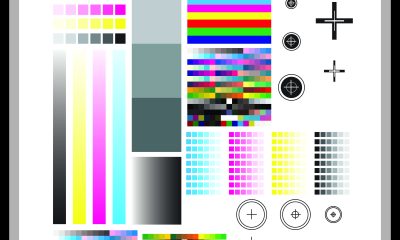News & Trends
How Digital Technology Is Killing Innovation
Published
12 years agoon

I love technology, always have. But we’re fast approaching the point where even techno geeks can’t keep up with the awesome display before us. There was a time when I couldn’t wait to see what was new. Over the last decade or so, the speed at which technology has accelerated has changed my perspective.
I love technology, always have. But we’re fast approaching the point where even techno geeks can’t keep up with the awesome display before us. There was a time when I couldn’t wait to see what was new. Over the last decade or so, the speed at which technology has accelerated has changed my perspective.
By way of background, I’ve just spent the last nine months re-evaluating everything I know about where we’ve been and where we’re going. This all came about with the decision to close my own print operation at the end of January, 2011, after 38 years. It was a very difficult decision, and I anguished over it for months. I didn’t close it because of the economy; there were other factors I won’t go into.
I came to some serious revelations while in the process of selling off equipment and disposing of almost 40 years worth of collected works. If you ever get a chance to go through a lifetime’s worth of work in a short period of time, the impact can be stunning. I’ve only done it once before, when my father passed away and I had to go through everything. It is a very weird feeling to see a life flash in front of you by going through what’s left behind.
Very few of us ever come face-to-face with our own lives in this manner. As I was going through my personal archives of saved print samples, journals, lab notebooks, and the like, I was initially excited. This is mostly because I was pulling out memories of great adventures from along the way. There were photos of when my wife and I visited Michel Caza in Cergy Pentoise in 1984 for the first time. There were the Gold, Silver, and Bronze Golden Squeegee Awards from the very first competition in 1980, along with the award-winning shirts. And much more.
It was amazing. There were pictures of a very young Andy Anderson, Don Newman, and Mark Coudray looking over samples in the Stretch Devices booth in 1986. As the chronology of work and time progressed, I could see something happening. I was watching innovation unfold in front of me. I was looking back at the history of digital imaging, color science, and halftone technology being played out before my very eyes.
AdvertisementThen, about 1998, something happened. The evolution of color, halftoning, separation technology—it all kind of stopped. I didn’t notice it at first, but it was definitely there. From that point on, the quality of our printing kept getting better and better, but the innovation stopped. There were only smaller and smaller refinements, and to be honest, hardly anything new since late 2006. It pains me to make that admission, but think about your own business or the screen side of the industry and tell me honestly I’m not the only one who sees it.
How we innovate going forward
Here’s what I’ve noticed. First and foremost, trades shows and the trade press started cutting back the number of seminars, columns, and features. They felt the crush of declining show attendance ad revenues. The events and publications got smaller and smaller. This is of major significance. It is the beginning of an accelerating decline.
Innovation is based on improvement. Improvement means doing things differently. To introduce and market any new technology successfully, you must have a market in place that understands the significance of the improvement and has a willingness and capacity to implement change. Furthermore, that change or improvement must demonstrate enough economic or market significance to justify the capital investment and the disruption within the organization.
When the primary educational channels are choked down to the point where nothing of significant substance can be delivered, you starve the end users in the market to the point where they jeopardize the successful launch and adoption of any new vendor technology because they are not prepared to deal with it.
This wasn’t a problem as long as we lived in the analog world. A major purchase would last for 20 years or more, and education could be delivered over time with no ill effect. Innovation was slower. Businesses could digest new knowledge at a more reasonable pace.
That all changed forever as soon as accelerated, disruptive, digital technologies appeared. Driven by Moore’s curve, processor density doubled every 18-24 months while the price of new technology dropped like a rock. If you invested early, or took too long to implement, you were dead. Your competitors would watch you struggle with early or beta versions. Hardware and software reliability were poor. In their tech-driven schedules, products were rushed to market before they were ready.
Both the vendors and your competitors would learn from your struggles. So when version 2.0 was released, you were economically done. Being in early was not necessarily a good thing unless you were an exceptional implementer with lots of savvy. I know. I’ve experienced the bleeding edge too many times.
It gets worse. When the technology vendors weren’t strong enough, you risked them going out of business before the market was mature enough for them to sell sufficient volumes to stay alive and profit. Think of the early days of DTG.
So, stepping back from this for a minute, I can see that the majority of innovation for screen printers peaked in about 1998 or thereabout. Digital technologies have maintained their relentless march forward, so much so that now we are having a convergence with the other printing disciplines like litho and flexo.
Competition and elbowing for marketshare is getting more and more intense. As bleak as this appears, all is not dark. We still possess one of the most fundamentally viable imaging technologies in the world. All of the perspectives I’ve just outlined are seen from the rear view mirror. Let’s start looking ahead. What are our options?
Creating new business
As much as I love imaging technology, my focus and attention have shifted. It’s now zeroed in on markets, opportunities, and the application of technology to them. There are new ways to define value in the market. There are more opportunities in front of us today than ever before, but we just aren’t recognizing them.
We’re trying to apply our old ways of looking at the game to a whole new game. It’s as if we’ve spent the last 100 years playing baseball and now the field has been changed over to soccer and we don’t know the rules, strategies, or the plays.
When I realized this, everything changed. I began to see things differently. I began to look at situations differently. Things would never be the same again. In the past, we all would look at a job based on three things: how much or many resources would it take, how much risk would be involved, and how much friction (hassle factor) was involved with the client, account, or market.
AdvertisementToday’s model now incorporates a fundamental new element. It is a self-perpetuating element. I now evaluate every deal by the three traditional points and a fourth component: how much new business will be created automatically if my business pursues the opportunity.
When I first thought of this, it really twisted my mind. Up to this point, we were treating every account, client, and deal pretty much as a one off. It was what I called the hunter-gatherer approach to sales and marketing—foraging for lots of small orders, every day, or going for the big one. Landing a whale meant eating for a long time, getting fat and lazy, and then slowly beginning to starve when trying to replace the source of sustenance when it was gone. The problem was daily foraging was getting pretty lean, and the whales had all gone offshore.
The point of this is simple. Your marketing effort going forward must contain a self-perpetuating element if you expect to survive. It’s a way of extending existing tech purchases and will help you buy time for training and learning new things until you can adjust to the new paradigm.
I’ve written a number of columns over the last few years about the need for accelerated learning and the exponential expansion of knowledge. We are at a critical crossroad right here, right now. Unless we find a new way of delivering current, relevant knowledge, in large quantities, to a receptive audience, that gets it, we’re on the way to demise.
I wish I could lay out the answers here, but space is too limited. But there are solutions. To start, I would highly recommend getting a copy of the excellent new book, “Business Model Generation,” by Alex Osterwalder and Yves Pigneur. Not only will it change the way you look at everything going on around you, but it will also give you a fundamental framework to design the changes I’ve proposed so far.
Keep all of this in mind as you walk the vast expanse of the trade show. Look at how our industry has changed and who the new players are. Screen printing is still here to be sure, but our role now is not necessarily one of print innovation; rather, it is one of how we bring our knowledge, technology, and value to the markets in more efficient and innovative ways.

SPONSORED VIDEO
Let’s Talk About It
Creating a More Diverse and Inclusive Screen Printing Industry
LET’S TALK About It: Part 3 discusses how four screen printers have employed people with disabilities, why you should consider doing the same, the resources that are available, and more. Watch the live webinar, held August 16, moderated by Adrienne Palmer, editor-in-chief, Screen Printing magazine, with panelists Ali Banholzer, Amber Massey, Ryan Moor, and Jed Seifert. The multi-part series is hosted exclusively by ROQ.US and U.N.I.T.E Together. Let’s Talk About It: Part 1 focused on Black, female screen printers and can be watched here; Part 2 focused on the LGBTQ+ community and can be watched here.
You may like
Advertisement

Arcus Printers Barracuda Conveyor Flatbed Cutter

The Profit Impact of a Market Dominating Position

Inkcups Announces New CEO and Leadership Restructure
Advertisement
Subscribe

Bulletins
Get the most important news and business ideas from Screen Printing magazine's news bulletin.
Advertisement
Most Popular
-

 Case Studies2 months ago
Case Studies2 months agoHigh-Density Inks Help Specialty Printing Take Center Stage
-

 Art, Ad, or Alchemy2 months ago
Art, Ad, or Alchemy2 months agoF&I Printing Is Everywhere!
-

 Andy MacDougall2 months ago
Andy MacDougall2 months agoFunctional and Industrial Printing is EVERYWHERE!
-

 Columns3 weeks ago
Columns3 weeks ago8 Marketing Mistakes Not to Make When Promoting Your Screen Printing Services Online
-

 Editor's Note3 weeks ago
Editor's Note3 weeks agoLivin’ the High Life
-

 Marshall Atkinson3 weeks ago
Marshall Atkinson3 weeks agoHow to Create a Winning Culture in Your Screen-Printing Business
-

 Thomas Trimingham2 months ago
Thomas Trimingham2 months ago“Magic” Marketing for Screen Printing Shops
-

 Case Studies3 weeks ago
Case Studies3 weeks agoScreen Printing for Texture and Depth












